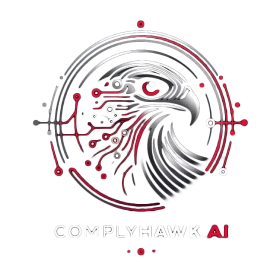In the burgeoning world of open finance, data security stands as a critical pillar. The advent of the Open Finance Data Security Standard (OFDSS) brings with it significant implications for Chief Information Security Officers (CISOs) across various regions, including the Middle East. In this thought leadership article, we will explore the OFDSS, provide FAQs about the standard, outline where to start for both fintechs and banks, discuss implementation strategies, and explain what it means for CISOs in the Middle East. Finally, we’ll show how ComplyHawk can assist with the automation of compliance tasks, from document requests to tests.
What is the Open Finance Data Security Standard (OFDSS)?
The OFDSS is a comprehensive framework designed to ensure the protection and secure handling of financial data in an open finance ecosystem. It establishes guidelines and best practices that financial institutions and fintech companies must adhere to, covering everything from data encryption and access controls to incident response and compliance monitoring.
Who Created the OFDSS?
The Open Finance Data Security Standard (OFDSS) has been developed by a coalition of industry leaders, including fintech Plaid, which has played a pivotal role in shaping its framework. Plaid’s expertise in financial technology and data security has informed many of the guidelines established in the OFDSS.
This collaboration brings together stakeholders from various sectors of finance, ensuring that the standard reflects a wide range of needs and addresses the complexities of open finance. By fostering a secure environment for financial data sharing, OFDSS aims to inspire trust among consumers and businesses alike, ultimately paving the way for a more innovative and interconnected financial landscape.
FAQs about the OFDSS
1. What is the OFDSS?
The OFDSS (Open Finance Data Security Standard) is a framework designed to enhance data security in the open finance sector.
2. Why was the OFDSS created?
The OFDSS was developed to address the growing need for robust data security measures in the open finance sector, mitigating risks associated with APIs and data sharing.
3. Who governs the OFDSS?
The OFDSS is governed by a consortium of financial industry stakeholders, including regulatory bodies, financial institutions, and technology providers.
4. Is compliance with the OFDSS mandatory?
While compliance is not mandatory, it is highly recommended for organizations involved in open finance.
5. What are the benefits of complying with the OFDSS?
Complying with the OFDSS can help organizations build trust with customers, partners, and regulators, enhancing their reputation.
6. How often is the OFDSS updated?
The OFDSS is periodically reviewed and updated to reflect new security challenges and technological advancements.
7. Can small businesses implement the OFDSS?
Yes, the OFDSS is designed to be scalable, making it applicable to organizations of all sizes.
8. What kind of data does the OFDSS protect?
The OFDSS focuses on protecting sensitive financial data shared through open finance channels.
9. Are there penalties for not complying with the OFDSS?
While there are no direct penalties, non-compliance may lead to reputational damage and loss of trust.
10. How can organizations get started with the OFDSS?
Organizations can begin by familiarizing themselves with the standard and assessing their current security practices against its guidelines.
11. What resources are available for implementing the OFDSS?
Numerous resources, including guidelines, toolkits, and best practices, are available from the governing consortium.
12. Does the OFDSS cover international regulations?
The OFDSS is primarily focused on the open finance sector but takes into account relevant international data security regulations.
13. How does the OFDSS relate to data privacy laws?
The OFDSS complements data privacy laws by providing additional security measures for handling sensitive financial information.
14. Are there certification programs for OFDSS compliance?
Yes, various organizations offer certification programs to help businesses demonstrate their compliance with the OFDSS.
15. What types of organizations should prioritize the OFDSS?
Any organization involved in open finance, including banks, fintechs, and data aggregators, should prioritize the OFDSS.
16. How does the OFDSS prevent data breaches?
The OFDSS provides a standardized set of security practices aimed at reducing vulnerabilities and strengthening data protection.
17. Can organizations customize their implementation of the OFDSS?
Yes, organizations can tailor their implementation to fit their unique needs while adhering to the core principles of the OFDSS.
18. What role do technology providers play in the OFDSS?
Technology providers contribute to the development and governance of the OFDSS, ensuring it addresses current technological challenges.
19. How is the effectiveness of the OFDSS measured?
The effectiveness of the OFDSS is assessed through ongoing evaluations, feedback from stakeholders, and monitoring of data security incidents.
20. Where can I find more information about the OFDSS?
Additional information can be found on the official OFDSS website and through industry publications related to open finance and data security.
Where to Start?
For Fintechs
Starting with compliance to OFDSS can seem daunting for fintechs, especially smaller startups. However, by following a structured approach, fintechs can achieve compliance efficiently:
- Conduct a Gap Analysis: Begin by assessing your current security posture against the OFDSS requirements. Identify areas where your existing practices fall short and prioritize them based on risk.
- Develop a Compliance Roadmap: Create a detailed plan outlining the steps needed to achieve compliance. This roadmap should include timelines, resources, and responsibilities.
- Engage Stakeholders: Ensure that all relevant stakeholders, including executive leadership, are on board and understand the importance of OFDSS compliance. This will help secure the necessary resources and support.
- Leverage Technology: Utilize technology solutions that can automate and streamline compliance tasks. For instance, platforms like ComplyHawk can assist with document requests, tests, and continuous monitoring.
For Banks
Banks, given their more extensive infrastructure and resources, may have a different starting point but still face significant challenges:
- Assess Existing Infrastructure: Banks should start by evaluating their existing security infrastructure and identifying areas that need enhancement to meet OFDSS standards.
- Integrate OFDSS into Risk Management Framework: Incorporate OFDSS requirements into your existing risk management and compliance frameworks. This will ensure that OFDSS compliance becomes an integral part of your overall security strategy.
- Continuous Training and Awareness: Regularly train and update your staff on OFDSS requirements and best practices. This will help maintain a high level of security awareness and preparedness across the organization.
- Collaborate with Fintech Partners: Banks often collaborate with fintech companies, making it essential to ensure that these partners also comply with OFDSS. Establish clear guidelines and expectations for fintech partners regarding data security.
How to Implement the OFDSS?
Implementing the OFDSS requires a systematic and phased approach. Here are some critical steps to consider:
1. Understand the Requirements
Thoroughly review the OFDSS documentation to understand the specific requirements and controls that need to be implemented. This includes data encryption, access controls, incident response, and more.
2. Conduct a Risk Assessment
Perform a comprehensive risk assessment to identify potential vulnerabilities and threats to your financial data. This will help prioritize the implementation of security controls based on risk levels.
3. Develop Policies and Procedures
Create and document policies and procedures that align with OFDSS requirements. Ensure that these documents are accessible to all relevant stakeholders and regularly reviewed and updated.
4. Implement Security Controls
Implement the necessary security controls, such as data encryption, multi-factor authentication, and intrusion detection systems. Ensure that these controls are continuously monitored and tested.
5. Monitor and Audit
Establish a monitoring and auditing process to ensure ongoing compliance with OFDSS. This includes regular security assessments, vulnerability scans, and penetration testing.
6. Continuous Improvement
Compliance is not a one-time effort. Continuously evaluate and improve your security practices to keep up with evolving threats and regulatory changes.
What Does the OFDSS Mean for CISOs in the Middle East?
The adoption of OFDSS in the Middle East comes with unique challenges and opportunities for CISOs in the region:
Challenges
- Regulatory Landscape: The regulatory environment in the Middle East can be complex, with varying requirements across different countries. CISOs must stay abreast of these regulations and ensure that OFDSS compliance aligns with local laws.
- Resource Constraints: Some organizations in the region may face resource constraints, making it challenging to allocate the necessary budget and personnel for OFDSS compliance.
- Cultural Barriers: There may be cultural differences in how data security is perceived and prioritized. CISOs need to foster a culture of security awareness and emphasize the importance of OFDSS compliance.
Opportunities
- Building Trust: Compliance with OFDSS can help organizations build trust with customers, partners, and regulators. This is particularly important in regions where trust in digital financial services is still developing.
- Competitive Advantage: Organizations that achieve OFDSS compliance can differentiate themselves from competitors by demonstrating their commitment to data security and privacy.
- Collaboration: The Middle Eastern financial sector is characterized by strong collaboration between banks and fintech companies. OFDSS compliance can facilitate smoother and more secure collaborations.
Common Controls Between OFDSS, ISO/IEC 27001, and PCI DSS
When navigating the compliance landscape, it’s crucial to understand the overlaps between various frameworks such as OFDSS, ISO/IEC 27001, and PCI DSS. Here are some common controls along with their respective clauses:
1. Access Control
- OFDSS Clause: Ensure that access to sensitive information is restricted to authorized users only.
- ISO/IEC 27001 Clause A.9: User access management, including user registration and deregistration, access rights, and access monitoring.
- PCI DSS Requirement 7: Restrict access to cardholder data by business need to know.
2. Data Encryption
- OFDSS Clause: Implement strong encryption practices to protect sensitive data in transit and at rest.
- ISO/IEC 27001 Clause A.10: Cryptographic controls, ensuring that appropriate encryption methods are employed.
- PCI DSS Requirement 3: Protect stored cardholder data through encryption and other measures.
3. Incident Management
- OFDSS Clause: Establish an incident response plan to address security breaches promptly.
- ISO/IEC 27001 Clause A.16: Information security incident management, which includes reporting, assessing, and responding to incidents.
- PCI DSS Requirement 12.10: Implement an incident response plan and test it regularly to ensure effectiveness.
4. Risk Assessment
- OFDSS Clause: Conduct regular risk assessments to identify and mitigate security risks.
- ISO/IEC 27001 Clause A.8: Assess risks to the organization’s information and take necessary measures to address them.
- PCI DSS Requirement 12.2: Develop and maintain a risk assessment process that is done at least annually.
5. Training and Awareness
- OFDSS Clause: Provide security training for all staff to enhance awareness of data security practices.
- ISO/IEC 27001 Clause A.7.2: Information security awareness, education, and training to promote a culture of security.
- PCI DSS Requirement 12.6: Implement a security awareness program to make all employees aware of the importance of cardholder data security.
By aligning these common controls, organizations can streamline their compliance efforts and enhance their overall security posture while meeting multiple regulatory requirements.
Main Differences Between OFDSS, PCI DSS, and ISO/IEC 27001
While OFDSS, PCI DSS, and ISO/IEC 27001 share common goals of enhancing data security and regulatory compliance, they also have distinct clauses that set them apart. Understanding these differences is essential for organizations to navigate their compliance strategies effectively.
1. Scope and Applicability
- OFDSS (Clause 1.1): Primarily focused on the financial sector within specific regulatory jurisdictions, it sets out requirements for financial data protection, especially concerning digital financial services.
- PCI DSS (Requirement 1.1): Designed specifically for organizations that handle cardholder data, this framework applies exclusively to payment card transactions to mitigate the risks of credit card fraud.
- ISO/IEC 27001 (Clause 1): A broader information security management standard that applies to all organizations regardless of size or industry, focusing on establishing, implementing, maintaining, and continually improving an information security management system (ISMS).
2. Risk Management Approach
- OFDSS (Clause 4.2): Emphasizes a continuous assessment of risks related to financial data and mandates specific security measures tailored for the financial sector.
- PCI DSS (Requirement 12.1): Requires organizations to conduct an annual risk assessment and provides specific guidelines on how to manage and mitigate risks associated with payment card data.
- ISO/IEC 27001 (Clause 6): Advocates for a flexible risk management process, allowing organizations to identify, evaluate, and treat information security risks in alignment with their business objectives and risk appetite.
3. Compliance and Auditing Process
- OFDSS (Clause 5.1): Involves regulatory oversight and may require organizations to undergo periodic audits to ensure compliance with financial regulations.
- PCI DSS (Requirement 3.2): Mandates a self-assessment questionnaire or formal assessments by Qualified Security Assessors (QSAs), depending on the volume of transactions processing.
- ISO/IEC 27001 (Clause 9): Requires organizations to undergo independent audits for certification and emphasizes the need for ongoing internal audits as part of the ISMS.
4. Specific Security Controls
- OFDSS (Clause 6.3): Details specific security controls concerning financial data, including data integrity measures and customer verification processes.
- PCI DSS (Requirement 4.1): Focuses heavily on controls around cardholder data, including encryption standards, network security measures, and customer authentication.
- ISO/IEC 27001 (Annex A): Provides a comprehensive set of controls across various aspects of information security, allowing organizations to select controls tailored to their risk environment.
By identifying these main differences, organizations can better allocate resources and tailor their compliance strategies to meet the expectations of each framework while enhancing their overall security posture.
What Can ComplyHawk Automate?
ComplyHawk is an automated compliance platform that can significantly ease the burden of OFDSS compliance for CISOs. Here are some key features:
Document Requests
ComplyHawk automates the process of managing and fulfilling document requests related to compliance. This ensures that all necessary documentation is readily available and up to date.
Tests
The platform can conduct automated tests to assess your organization’s compliance with OFDSS requirements. This includes vulnerability scans, penetration tests, and security assessments.
Continuous Monitoring
ComplyHawk provides continuous monitoring of your security posture, alerting you to any potential compliance issues or vulnerabilities in real time. Continuous risk assessment is a key differentiator for OFDSS.
Ready to simplify your OFDSS compliance journey? Book a demo of ComplyHawk today to find out more.
Final Thoughts
The Open Finance Data Security Standard (OFDSS) represents a significant step forward in ensuring the security and privacy of financial data in the open finance ecosystem. For CISOs, particularly those in the Middle East, achieving OFDSS compliance is essential for building trust, gaining a competitive edge, and navigating the complex regulatory landscape. By leveraging technology solutions like ComplyHawk, organizations can streamline their compliance efforts and focus on what matters most – delivering secure and innovative financial services.



